Summary
Revista Brasileira de Ginecologia e Obstetrícia. 2018;40(1):11-19
To evaluate the relation between changes the body mass index (BMI) percentile, reflected in the Atalah curve, and perinatal outcomes.
A cross-sectional study with 1,279 women was performed. Data regarding gestational weight, sociodemographic characteristics and perinatal outcomes were collected through medical charts, prenatal card and interviews in the postpartum period. Women could be classified according to the Atalah curve in the following categories: low weight, adequateweight, overweight, and obese. The BMIwas calculated at the first and at the last prenatal care visits, and these values were compared.
An increase in the BMI category according to the Atalah classification occurred in 19.9% of pregnant women, and an increase of 3.4, 5.8 and 6.4 points of BMI were found for women respectively classified in the adequate weight, overweight and obese categories at the first prenatal visit. Women with high school education presented a lower chance of increasing their BMI (odds ratio [OR] 0:47 [0.24- 0.95]). Women who evolved with an increase in the the Atalah classification were associated with cesarean section (OR 1.97-2.28), fetalmacrosomia (OR 4.13-12.54) and large for gestational age newborn (OR 2.88-9.83).
Pregnant women who gained enough weight to move up in their BMI classification according to the Atalah curve had a higher chance of cesarean section and macrosomia. Women classified as obese, according to the Atalah curve, at the first prenatal visit had a high chance of cesarean section and delivering a large for gestational age newborn.
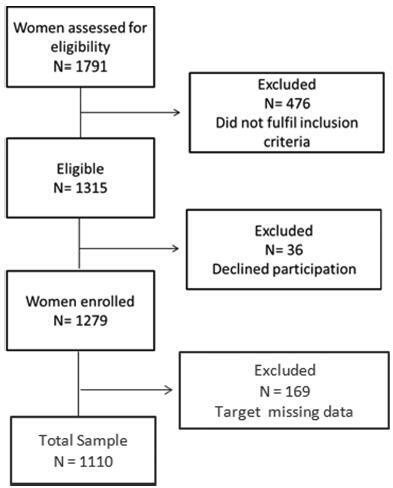
Summary
Revista Brasileira de Ginecologia e Obstetrícia. 2017;39(3):110-114
To describe the frequencies of chromosomal abnormalities found in abortion material, and to observe its correlation to maternal age.
A retrospective study was conducted based on data obtained from the databank of a medical genetics laboratory in Belo Horizonte, MG, Brazil. A total of 884 results from products of conception analysis were included, 204 of which were analyzed by cytogenetics, and 680bymolecular biology basedon quantitative fluorescence polymerase chain reaction (QF-PCR). The frequency of individual chromosomal aberrations and the relationship between the presence of anomalies and maternal age were also evaluated.
The conventional cytogenetics technique was able to detect 52% of normal and 48% of abnormal results in the analyzed material. Quantitative fluorescence polymerase chain reaction revealed 60% of normal and 40% of abnormal results from the samples evaluated by this method. The presence of trisomy 15 was detected only by cytogenetics, as it was not included in the QF-PCR routine investigation in the laboratory. A significant increase in abnormal results was observed among women aged 35 years or older compared with younger women (p = 0.02).
Chromosomal aberrations are still a major cause of spontaneous abortion, and the conventional cytogenetics technique is efficient for miscarriage material analysis, but molecular methods such as QF-PCR are adequate complementary strategies to detect the major chromosomal anomalies, leading to technical reports with reliable results.
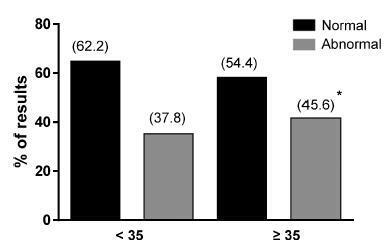
Summary
Revista Brasileira de Ginecologia e Obstetrícia. 2015;37(3):110-114
DOI 10.1590/SO-720320150005258
To assess the reproductive outcomes after hysteroscopic septoplasty.
A retrospective observational study was performed with analysis of the medical records of 28 women with infertility or recurrent abortions undergoing hysteroscopic septoplasty. To evaluate reproductive outcomes we consulted the medical records of our hospital and of primary health care units between septoplasty and the present or first pregnancy. Primary outcomes were pregnancy rate, newborns, and abortions after septoplasty. Uterine septum was diagnosed by 2D or 3D ultrasound and classified according to the American Fertility Society. All procedures were performed in the follicular phase of the menstrual cycle using monopolar or bipolar energy and/or microscissors. To compare the reproductive outcomes before and after septoplasty we used Microsoft Excel and SPSS version 17. Fisher's exact test was considered statistically significant if p<0.05.
Hysteroscopic septoplasty was performed in 20 patients (72%) with secondary infertility and in 8 patients (28%) with primary infertility. The septum was incompletely removed during the first hysteroscopy in 5 cases (18%), which required a second surgery. One case was complicated with minor uterine perforation. After hysteroscopic septoplasty, 64% of women became pregnant and 48% live neonates were delivered; 4% of the patients had a tubal pregnancy; and 19% had miscarriages.
The results of this study are consistent with those described in the literature. Patients obtained a significant improvement of reproductive outcomes with a fivefold reduction in miscarriage rate after hysteroscopic septoplasty.
Summary
Revista Brasileira de Ginecologia e Obstetrícia. 2022;44(12):1102-1109
To evaluate the use of misoprostol prior to hysteroscopy procedures regarding technical ease, the presence of side effects, and the occurrence of complications.
This is a retrospective, observational, analytical, case-control study, with the review of medical records of 266 patients followed-up at the Gynecological Videoendoscopy Sector of the Hospital das Clínicas da Faculdade de Medicina de Ribeirão Preto of the Universidade de São Paulo (HCFMRP – USP, in the Portuguese acronym) from 2014 to 2019, comparing 133 patients who used the drug before the procedure with 133 patients who did not.
The occurrence of postmenopausal uterine bleeding was the main indication for hysteroscopy and revealed a statistical difference between groups (p < 0.001), being present in 93.23% of the patients in the study group and in 69.7% of the patients in the control group. Only 2 patients (1.5%) in the study group reported adverse effects. Although no statistical differences were observed regarding the occurrence of complications during the procedure (p = 0.0662), a higher total number of complications was noted in the group that used misoprostol (n = 7; 5.26%) compared with the group that did not use the drug (n = 1; 0.75%), a fact that is clinically relevant. When evaluating the ease of the technique (measured by the complete performance of all steps of the hysteroscopy procedure), it was verified that although there was no difference between groups (p = 0.0586), the control group had more than twice as many incompletely performed procedures (n = 17) when compared with the group that used misoprostol previously (n = 8), which is also clinically relevant.
The use of misoprostol prior to hysteroscopy in our service indicated that the drug can facilitate the performance of the procedure, but not without side effects and presenting higher complication rates.
Summary
Revista Brasileira de Ginecologia e Obstetrícia. 2011;33(3):111-117
DOI 10.1590/S0100-72032011000300002
PURPOSE: to assess the distance of the fetal cerebral fissures from the inner edge of the skull by three-dimensional ultrasonography (3DUS). METHODS: this cross-sectional study included 80 women with normal pregnancies between 21st and 34th weeks. The distances between the Sylvian, parieto-occiptal, hippocampus and calcarine fissures and the internal surface of the fetal skull were measured. For the evaluation of the distance of the first three fissures, an axial three-dimensional scan was obtained (at the level of the lateral ventricles). To obtain the calcarine fissure measurement, a coronal scan was used (at the level of the occipital lobes). First degree regressions were performed to assess the correlation between fissure measurements and gestational age, using the determination coefficient (R²) for adjustment. The 5th, 50th and 95th percentiles were calculated for each fissure measurement. Pearson's correlation coefficient (r) was used to assess the correlation between fissure measurements and the biparietal diameter (BPD) and head circumference (HC). RESULTS: all fissure measurements were linearly correlated with gestational age (Sylvian: R²=0.5; parieto-occiptal: R²= 0.7; hippocampus: R²= 0.3 and calcarine: R²= 0.3). Mean fissure measurement ranged from 7.0 to 14.0 mm, 15.9 to 28.7 mm, 15.4 to 25.4 mm and 15.7 to 24.8 mm for the Sylvian, parieto-occiptal, hippocampus and calcarine fissures, respectively. The Sylvian and parieto-occiptal fissure measurements had the highest correlations with the BPD (r=0.8 and 0.7, respectively) and HC (r=0.7 and 0.8, respectively). CONCLUSION: the distance from the fetal cerebral fissures to the inner edge of the skull measured by 3DUS was positively correlated with gestational age.
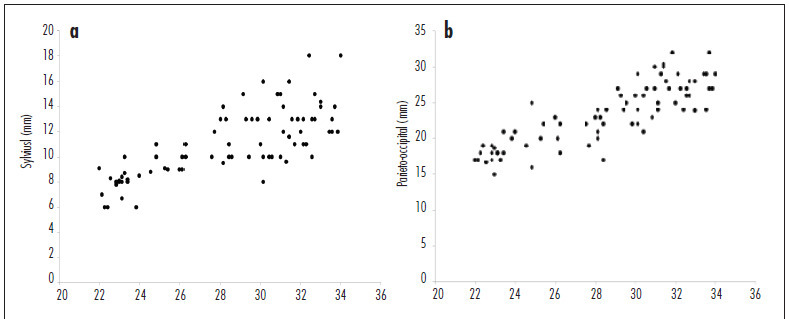
Summary
Revista Brasileira de Ginecologia e Obstetrícia. 1998;20(2):111-113
DOI 10.1590/S0100-72031998000200009
The acardius syndrome is a rare complication of monozygotic twin pregnancies, occurring once in 35.000 births. The outcome is invariably fatal for the acardiac twin and for 50-75% of the normal twins. We report a case of partial (pseudo)acardia in twin pregnancy. The diagnosis was made using ultrasonography, fetal echocardiography and confirmed after delivery.
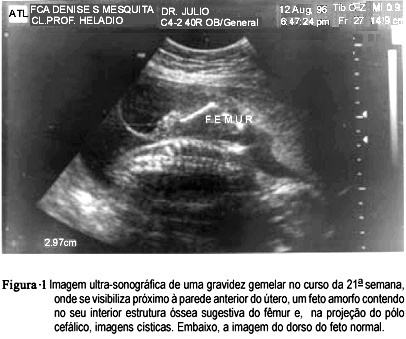
Summary
Revista Brasileira de Ginecologia e Obstetrícia. 2004;26(2):111-116
DOI 10.1590/S0100-72032004000200005
PURPOSE: to evaluate the characteristics of sexual violence against women, the types of sexual crimes and resulting body lesions. METHODS: descriptive study based on the information obtained from the medical records of 102 victims of sexual violence who were seen at the Maria-Maria project from March 2002 to March 2003 and who fulfilled the eligibility criteria. The characteristics of the violence, the types of crimes and the body injuries are described. For calculation and analysis of the data, the Epi-Info, version 6.04, program, for simple percentages and frequency distribution were used. RESULTS: ages of the victims ranged from 1 to 68 years, 65.7% were younger than 20 years and one in four was younger than 9 years. The majority were single (78.3%) and with a low educational level (74.2%). The crime predominated at night (64.7%), in a secluded area (39.2%), followed by the victim's home (34.3%), and at the location of the attack (67.6%). Among the adolescent victims, the unknown attacker predominated, while among the children the attackers were men known to the victims. In the case of the children younger than 10 years, indecent assault was the most frequent crime (73.8%) while rape was the most frequent crime among the adolescents (66.4%). Body trauma occurred in 76.7% of the cases, mainly hematomas, vulva edema and abrasions. CONCLUSION: sexual violence predominated among children and adolescents, single women and with low educational level. The aggression happened more frequently during the night, by an unknown person, in a secluded area, in the case of adolescents, and by a known person (mainly neighbour), in the victim's home, in the case of children. Rape was the most frequent kind of crime among adolescents and among children it was indecent assault, usually associated with genital and corporeal trauma.
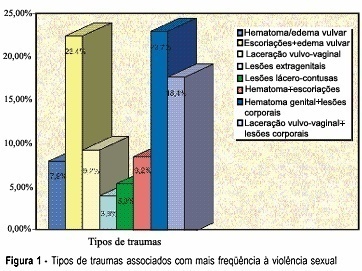
Summary
Revista Brasileira de Ginecologia e Obstetrícia. 2013;35(3):111-116
DOI 10.1590/S0100-72032013000300004
PURPOSE: To evaluate the frequency of fear of needles and the impact of a multidisciplinary educational program in women with pre-gestational and gestational diabetes taking insulin during pregnancy. METHODS: The short Diabetes Fear of Injecting and Self-testing Questionnaire (D-FISQ), composed by two subscales that access fear of self injection (FSI) and fear of self testing (FST), was administered twice during pregnancy to 65 pregnant women with pre-gestational and gestational diabetes: at the first endocrine consult and within the last two weeks of pregnancy or postpartum. An organized multidisciplinary program provided diabetes education during pregnancy. Statistical analysis was carried out by Wilcoxon and McNemar tests and Spearman correlation. A p<0.05 was considered to be significant. RESULTS: Data from the short D-FISQ questionnaire shows that 43.1% of pregnant women were afraid of needles in the first evaluation. There was a significant reduction in scores for FSI and FST subscales between the first and second assessments (first FSI 38.5% compared with second 12.7%, p=0.001; first FST 27.7% compared with second FST 14.3%, p=0.012). CONCLUSIONS: The fear of needles is common in pregnant women on insulin therapy and an organized multidisciplinary educational diabetes program applied during pregnancy reduces scores of such fear.